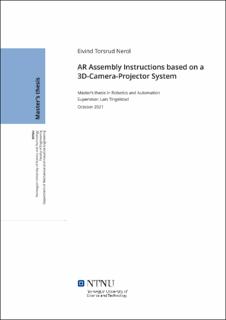| dc.contributor.advisor | Tingelstad, Lars | |
| dc.contributor.author | Nerol, Eivind Torsrud | |
| dc.date.accessioned | 2021-10-05T17:36:43Z | |
| dc.date.available | 2021-10-05T17:36:43Z | |
| dc.date.issued | 2021 | |
| dc.identifier | no.ntnu:inspera:78072783:47638423 | |
| dc.identifier.uri | https://hdl.handle.net/11250/2787884 | |
| dc.description.abstract | Siden 1975 har Aker Solutions Verdal produsert stål “jacket” understell for offshore olje- og gassplattformer. Verftet i Verdal har en sterk posisjon i markedet, men på grunn av den globale høye stålprisen og de høye lønningene i Norge, så fører det til at verftet er mindre konkurransedyktig og mister kontrakter til andre utenlandske verft. Automasjon i produksjonen av jacketer kan føre til et mer moderne verft med raskere produksjon, bedre nøyaktighet og mindre bemanning som sikrer flere kontrakter inn i fremtiden.
SINTEF Manufacturing har initiert et prosjekt, AutoKons, sammen med Aker Solutions Verdal som undersøker problemer i fabrikasjonsprosedyren av jacketer. Slike konstruksjoner er ofte av kategorien “et stykk” produksjon og består av tunge dimensjoner som fører til problemer innen geometrisk nøyaktighet med tidskrevende operasjoner som kutting, løfting, markering og sveising.
En jacket er en struktur som er bygd av runde rør og har typisk fire “leger” som knyttes sammen av en rekke avstivere, “bracings”. Når bracingen skal monteres på legen kommer stub montasjen inn. Istedenfor å montere bracingen direkte på legen, kommer stuben inn som et lite koblet rørstykke mellom leg og bracing. Stubens oppgave er å gjøre det enklere å justere bracingen slik at den kommer i riktig posisjon og vinkel. Før stuben sveises på legen, så må glødeskall og sveisesømmer fjernes med sliping i området der tverrsnittet til stuben treffer legens overflate. For å vite hvor man skal slipe løftes stuben opp etter at dens tverrsnittet er kuttet ut i ønsket konfigurasjon, for å så markere med kritt. I denne operasjonen er man avhengig av kran, noe som blir ansett som tidskrevende og sinker andre oppgaver i fabrikasjonsområdet.
Denne masteroppgaven har undersøkt å lage et system bestående av et 3D kamera og en projektor med utgangspunkt i å unngå overnevnte kranoperasjon for markering. Istedenfor å løfte opp og markere manuelt, så markeres stubens tverrsnitt med en projektor. Bildet som deretter blir projisert igjennom projektorens bildeplan vil fremheve området på legens overflate, der platearbeideren/sveiseren skal slipe istedenfor å løfte opp og manuelt markere. En integrasjon av dette i dagens prosedyre kan føre til færre kranoperasjoner, og dermed en mer effektiv montering. Det er gjennomført ulike tester med både syntetisk og ekte data der stuber er definert i ulike konfigureringer med en transformasjon fra det definerte referansesystemet. Med gitte antagelser som at referansesystemet og det projiserte tverrsnittet ikke er sammenlignet mot et virkelig tverrsnitt i samme konfigurasjon, så ser man at resultatene er nær posisjonstoleransene for rørknutepunkt i standarden NORSOK-M101, Structural steel fabrication.
Skjæringskurvaturen som blir definert av skjæring mellom meshene i den implementerte metoden kan også nyttes inn i andre applikasjoner i dagens stubmontasje som kutting og sveising ved å flytte kurvaturens koordinater over i et robotkoordinatsystem ved hjelp av en hånd-øye kalibrering. | |
| dc.description.abstract | Since 1975, Aker Solutions Verdal has provided steel jacket substructures for offshore oil and gas platforms. The yard in Verdal has a strong position in the market. Nevertheless, the global steel-price impact and the high salaries in Norway contribute to the yard being less competitive and losing contracts to foreign yards. Automation in the production would lead to a more modern yard with faster production, higher accuracy, and less staffing need to ensure more contracts in the future.
SINTEF Manufacturing has, in collaboration with Aker Solutions Verdal initiated a project, AutoKons. The project addresses challenges in the manufacturing procedure of jackets, which are often one-piece productions. Such one-piece jackets consist of large, heavy components that face challenges within geometric accuracy and time-consuming tasks such as cutting, lifting, marking, and welding.
A jacket is a structure built of round tubes and typically has four or more legs connected by a series of bracings. When assembling the bracing onto the leg, a stub is used to connect the bracing to the leg. Instead of mounting the bracing directly onto the leg, a stub makes it easier to align the bracing in the right position and angle. Before the stub is welded onto the leg, embers and welding seams must be grinded away in the area where the stub hits the leg. The stub is lifted up after its cross-section cut has been cut out in the desired configuration and marked with chalk to know where to grind. In this operation, one is dependent on cranes which are considered time-consuming and delay other tasks in the manufacturing area.
This thesis investigates creating a system consisting of a 3d camera with a projector based on avoiding the above-mentioned crane operation for marking. Instead of lifting and marking manually, the stub’s cross section cut is marked with a projector. The projected image will highlight the area on the leg’s surface on which the sheet metal worker/welder should grind. An integration of this in the
current procedure can lead to fewer crane operations, and thus a more efficient installation.
Various experiments are performed with synthetic and real data where stubs in different configurations are transformed from the defined reference system. With certain assumptions, such as the reference system and the projected cross-section not being compared to a real cross-section in the same configuration, it is seen that results are obtained close to the position tolerances for tubular nodes in the standard NORSOK-M101, Structural steel fabrication.
The implemented method also has the possibility of being extended to other applications within the current stub assembly procedure. The intersection path between the meshes in the implemented method can also be used in automation of cutting and welding by the use of robotic systems with hand-eye calibration. | |
| dc.language | eng | |
| dc.publisher | NTNU | |
| dc.title | AR Assembly Instructions based on 3D Camera and Projector | |
| dc.type | Master thesis | |
